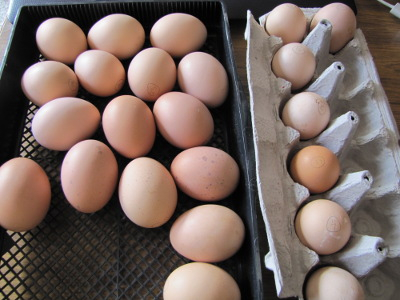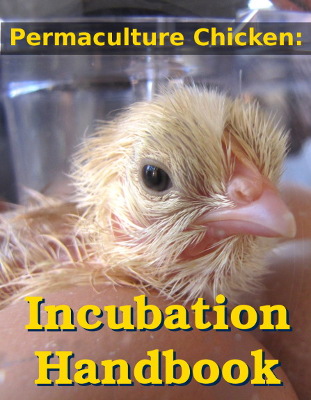
Choosing hatching eggs
 If
you want a perfect hatch, you need to start with perfect eggs.
Factors that influence an egg's hatchability include whether the egg
was fertilized, whether the shell is in good shape, and how the egg was
stored. Below, I've included the section on seasons and parentage
from Permaculture
Chicken: Incubation Handbook --- be sure to check out the
book to learn more about selecting eggs with a good shape and shell
quality, how to store eggs before they go in the incubator, and what to
expect with mail order eggs.
If
you want a perfect hatch, you need to start with perfect eggs.
Factors that influence an egg's hatchability include whether the egg
was fertilized, whether the shell is in good shape, and how the egg was
stored. Below, I've included the section on seasons and parentage
from Permaculture
Chicken: Incubation Handbook --- be sure to check out the
book to learn more about selecting eggs with a good shape and shell
quality, how to store eggs before they go in the incubator, and what to
expect with mail order eggs.
Time of year deserves
consideration as you plan your hatch.
I
prefer to
incubate chicks in February and March so they're out on pasture during
the peak grass-growing season of March through June, then I start
another batch in late summer to take advantage of the secondary pasture
peak in September through November. If you're revitalizing your
 laying flock, it's important
to have chicks out of the shell by
early to mid April to ensure they are old enough to lay before days
shorten in the fall. Otherwise, you'll be feeding non-laying
pullets all winter.
laying flock, it's important
to have chicks out of the shell by
early to mid April to ensure they are old enough to lay before days
shorten in the fall. Otherwise, you'll be feeding non-laying
pullets all winter.
However, chicken biology
dictates a slightly different hatch pattern. As you can see in
this chart, eggs tend to be most fertile in March through June,
with a secondary peak in fertility in September and October.
Don't feel obliged to follow the chart's lead, but do be aware that
your results won't be quite as good if you're trying to raise chicks in
the dead of winter.

A related issue is the
health of the eggs' parents. Older poultry
manuals admonish you to keep your breeding stock out on lush pasture,
since the high nutrition forage results in eggs that are more likely
to hatch. In my own experience, I've found that breeds of
chickens that produce brighter yolked eggs (meaning that the hens ate
more bugs and greenery) have higher hatch rates.
 While we're on the topic of
parents, feed isn't the only important
factor. Hens and roosters who have just become sexually active or
who are more than two years old will produce fewer fertile
eggs. I once tried to hatch eggs from four year old hens and
had abysmal results, convincing me that even if these hens are still
laying, most of the embryos aren't viable enough to mature.
While we're on the topic of
parents, feed isn't the only important
factor. Hens and roosters who have just become sexually active or
who are more than two years old will produce fewer fertile
eggs. I once tried to hatch eggs from four year old hens and
had abysmal results, convincing me that even if these hens are still
laying, most of the embryos aren't viable enough to mature.
Of course, you must have
a rooster if you want chicks (even though a
hen will lay unfertilized eggs when no males are around). Some
chicken keepers report issues with their roosters not mating frequently
enough to ensure that all eggs are fertilized, but I've never had that
problem. On the other hand, I keep fewer hens than the
recommended dozen per rooster, so my flock's patriarch doesn't have to
work too hard to do his job.
Inbreeding is a more
tricky issue for the backyard chicken
keeper. You may need to trade roosters with like-minded friends
every year, or buy a round of straight run chicks to
raise a new rooster annually, ensuring that your hens aren't
mating with their brothers or fathers. Inbreeding tends to lead
to lower hatch rates and to a higher proportion of sick chicks out of
the
eggs that do hatch.
 This post is part of our Chicken Incubation lunchtime series.
Read all of the entries: This post is part of our Chicken Incubation lunchtime series.
Read all of the entries: |
Want more in-depth information? Browse through our books.
Or explore more posts by date or by subject.
About us: Anna Hess and Mark Hamilton spent over a decade living self-sufficiently in the mountains of Virginia before moving north to start over from scratch in the foothills of Ohio. They've experimented with permaculture, no-till gardening, trailersteading, home-based microbusinesses and much more, writing about their adventures in both blogs and books.
Want to be notified when new comments are posted on this page? Click on the RSS button after you add a comment to subscribe to the comment feed, or simply check the box beside "email replies to me" while writing your comment.
- Remove comment
- Remove comment
- Remove comment
- Remove comment
